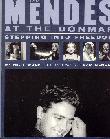SEARCH CurtainUp
REVIEWS
FEATURES
NEWS
Etcetera and
Short Term Listings
LISTINGS
Broadway
Off-Broadway
BOOKS and CDs
OTHER PLACES
Berkshires
London
LA/San Diego
Philadelphia
Elsewhere
QUOTES
On TKTS
LETTERS TO EDITOR
FILM
LINKS
MISCELANEOUS
Free Updates
Masthead
NYC Weather
Cavalia: A Magical Encounter Between Horse and Man
By Ariana Mufson
|
The horse is God's gift to man. --- Arabian Proverb
|
Of course, these horses have been impeccably trained by co-directors Frederic Pignon and Magali Delgado, "horse whisperers" who prefer a relationship of trust over one of dominance and force. This became evident at the end of the show when Pignon tried to persuade three Lusitano stallions to lie down--a trick much harder than it seems, considering the innate competitive and aggressive nature of stallions. One refused. Another lay down but then started to get up. Pignon, with infinite patience, murmured and coaxed, smiling all the while. Finally, all three listened, and the audience burst into applause. These unscripted moments are what make the show even more of a success. We feel privy to a secret meeting between horse and human. Horse enthusiasts and non-equestrians alike will be captivated by the show's demonstration of skill and grace.
Cavalia traces the evolution of the horse and human "relationship." Fortunately, it excludes the brutality with which most humans treat horses. Though Cavalia does its part in inspiring awe of and greater respect for the horse, it makes one wish there were a donation box or an announcement urging the support for the horse foundations that are necessary to protect these magnificent animals.
The first act begins with projections of horse related quotes glorifying the horse, ranging from Arabian proverbs to Shakespeare. Other projections depict the horse in ancient art, a forest and the Roman coliseum. Costumes and scenery evoke ancient Greece, Rome, and Arthurian legend. In the second act, we're on the western frontier with cowboys and Indian trick riders gallopimg across the stage performing acrobatics that make the audience gasp and applaud. At one point, aerialists dangle from the ceiling, twirling and twisting as horses jump poles down below. The effect is so dizzying and exhilarating that we want to leap up onto the horses ourselves to experience the feeling of flight.
There are also more subtle moments. Dressage, when the horse carries out precise controlled movements in response to minimal signals from its rider, is a prominent feature of the show. For those not familiar with the equestrian technique, the horses look as if they are dancing-- sometimes in beat to the music, other times with each other and their riders. Cavalia is not just about the spectacle and excitement but leaves us feeling that we have witnessed an entirely balanced show, one where the horses not only perform and play, but dance.
When the performers take their final bows, a sigh of disappointment echoes throughout the white top-just before every audience member jumps up to give a standing ovation. Even though mostly human actors are on stage at the end, the applause is really for the horses. Luckily, a few remain upstage for us to watch, as they roll and mill about-- wonderfully oblivious to the fact that they are so captivating.
To watch the horse in such an atmosphere is magic. Lucky for us, Cavalia is magic as well.
| Cavalia Creator and Artistic Director: Normand Latourelle Director and Visual Designer: Erick Villeneuve Equestrian Co-Directors: Frederic Pignon and Magali Delgado Cast: Frederic Barrette, Dosbergen Bektursunovich, Renaud Blais, Olivier Bousseau, Kansas Carradine, Estelle Delgado, Magali Delgado, Anne Gendreau, Erik Martonovich, Faissal Moulid, Mustapha Moulid, Damian Pichardo, Frederic Pignon, Elhassan Rais, Nadia Richer, Alethea Shelton, Enrique Suarez, Pierre-Luc Sylvain, Cedric Texier, Philippe Tezenas, Karen Turvey (Plus thirty-seven horses.) Musicians: Eric Boudreault, Jean-Francois Dery, Marie-Soleil Dion (vocals), Sylvain Gagnon, Jen-Francois Goyette, Caroline Lemay, Catherine LeSaulnier Choreography: Alain Gauthier and Brad Denys Set Design: Marc Labelle Lighting Design: Alain Lortie Costume Design: Mireille Vachon Sound Design: Jerome Boisvert Score: Michael Cusson Trainer: Andre St-Jean Running Time: 2 hours with a 20 minute intermission Running Dates: 11/10/04 to 1/02/05 Santa Monica Pier, under the Big White Top Price: $62-$92 (Student and senior discounts offered Mon.-Thurs.) For information and reservations: 866-999-8111 or www.cavalia.net Reviewed by Ariana Mufson on December 2, 2004. |

Retold by Tina Packer of Shakespeare & Co. >Click image to buy.
Our Review

Mendes at the Donmar
Our Review

At This Theater

Leonard Maltin's 2003 Movie and Video Guide

Ridiculous!The Theatrical Life & Times of Charles Ludlam

6, 500 Comparative Phrases including 800 Shakespearean Metaphors by CurtainUp's editor.
Click image to buy.
Go here for details and larger image.



